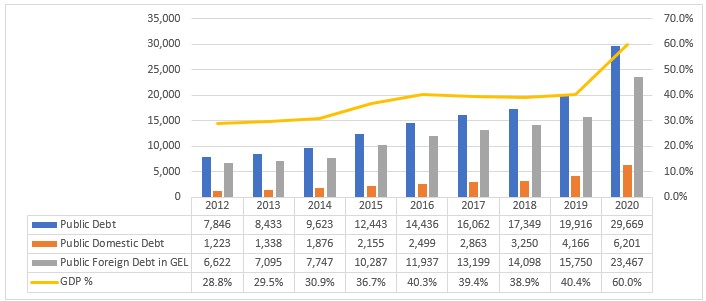European Georgia: “The result of the Georgian Dream’s faulty economic policy: state foreign debt exceeded the allowed threshold and reached GEL 31.9 billion which constitutes 61.3% of the GDP.”
Verdict: FactCheck concludes that European Georgia’s statement is a LIE.
Resume: European Georgia’s Facebook publication is about the indicators published by the National Bank of Georgia which, in contrast to the figures published by the Ministry of Finance, also include the obligations of state-owned enterprises and in essence are different from the indicator known by the wider public as state foreign debt. The threshold named in the statement is provided in the Law of Georgia on Economic Freedom which says that the allowed threshold of the total government debt (aggregated sum of domestic and foreign debts) to the GDP ratio is 60%. It is not appropriate to use the National Bank’s indicator vis-à-vis the legally allowed 60% threshold since the cumulative figure in European Georgia’s statement is not a subject of the legal capping.
Of additional note is that the government total debt (the not foreign debt taken separately) officially exceeds the legally allowed 60%, mostly for reasons arising from the pandemic-induced crisis. However, the government debt includes both the domestic and the foreign debt and the official foreign debt figure taken separately has not exceeded the 60% threshold. At the same time, the GEL to USD exchange rate fluctuation needs to be taken into account when speaking about debt growth. The total government debt mostly increased because of the growth of the foreign debt. The GEL-denominated foreign debt is strongly affected by the exchange rate fluctuations. The government, however, can only partly be held accountable for the sharp depreciation of GEL since 2014.
Given the aforementioned reasons, the first part of the statement which targets the results of the Georgian Dream’s economic policy is manipulative because it leaves the exchange rate swings and the impact of the pandemic-induced crisis over the debt figures out of context. The claim that the foreign debt exceeded the limit is wrong whilst the figures at the end of the statement are out of context. Therefore, FactCheck concludes that the statement is a LIE.
Analysis
The European Georgia – Movement for Freedom political party made a Facebook publication with the following content: “The result of the Georgian Dream’s faulty economic policy: state foreign debt exceeded the allowed threshold and reached GEL 31.9 billion which constitutes 61.3% of the GDP.”
To begin, of mention is that the publication refers to the indicators published by the National Bank of Georgia harmonised with the balance of payments. This includes the public sector (government, state-owned enterprises and the National Bank) external debt. According to the National Bank of Georgia, the total public sector external debt is USD 9.7 billion (GEL 31.9 million) as of 2020 which is 61.3% of the GDP. Of that amount, the government debt is USD 7.4 billion (USD 24.3 billion, 46.8% of the GDP), the external liabilities of the National Bank constitute USD 583.2 million (GEL 1.9 billion, 3.7% of the GDP) whilst the bonds and the loans of public enterprises are USD 802.7 million (GEL 2.6 billion, 5.1% of the GDP) and USD 923.6 million (GEL 3.0 billion, 5.8% of the GDP), respectively.
The threshold named in the statement is provided in the Law of Georgia on Economic Freedom which says that the allowed threshold of the total government debt (the sum of the domestic and the foreign debts) to the GDP ratio is 60%. However, Georgian legislation renders it possible to borrow beyond the thresholds set by this law in the case of the declaration of martial law or a state of emergency and if there is a need to fund measures to liquidate those consequences which arose as a result of the declaration of martial law/state of emergency. At the same time, the Government of Georgia has to submit a plan to the Parliament of Georgia to restore the legally prescribed parameters. The plan for returning to the legally prescribed parameters should not exceed three years. In the past, the aforementioned law set a 60% threshold for the allowed government debt.
It should be clarified that the official debt statistics provided by the Ministry of Finance and the figures published by the National Bank (which are named in the Facebook publication) are different numbers and are calculated with different methodologies. Therefore, putting the National Bank’s figure vis-à-vis the legally allowed 60% is not relevant. There are no thresholds imposed for the indicator named in European Georgia’s publication.
According to the Law of Georgia on Public Debt, The public debt of Georgia is the total amount of the domestic and the external debts, expressed in the national currency, taken through agreements entered into by the Ministry of Finance of Georgia on behalf of Georgia and, with guarantees provided by the Ministry of Finance, by other bodies/institutions, also in amounts received from the placement of government securities denominated in the national and foreign convertible currency by the Ministry of Finance of Georgia on behalf of Georgia and received from the financial resources approved by the International Monetary Fund for Georgia. It is clear from this definition that in order to have an obligation registered as public debt, it is necessary that the Ministry of Finance is involved when this obligation arises. According to the aforementioned debt definition, public debt includes the central government’s debt, the National Bank’s debt and the private sector’s debt guaranteed by the government whilst the National Bank’s figure includes the obligations of public enterprises as well (for more details click here).
Public debt statistics relevant vis-à-vis the legally allowed 60% threshold are given in Graph 1.
Graph 1: Public Debt Statistics in 2012-2020.

Source: Ministry of Finance of Georgia
In this case, too, it is evident that the public debt figure reached 60% mostly because of the pandemic-induced crisis. At the same time, the GEL to USD exchange rate fluctuation needs to be taken into account when speaking about debt growth. The total government debt mostly increased because of the growth of the foreign debt. The GEL-denominated foreign debt is strongly affected by the exchange rate fluctuations. The government, however, can only partly be held accountable for the sharp depreciation of GEL since 2014.








